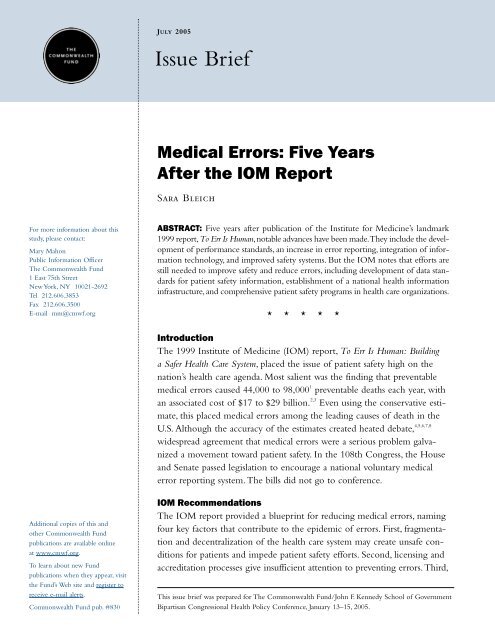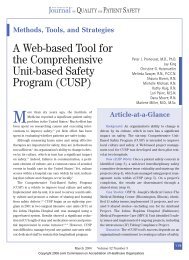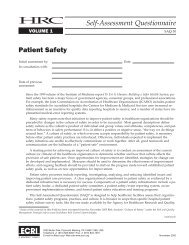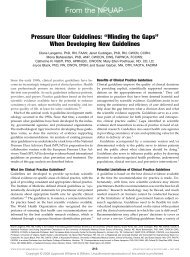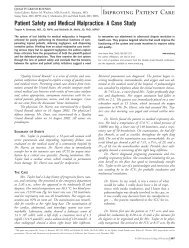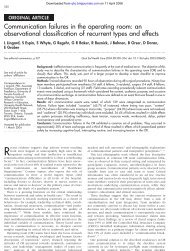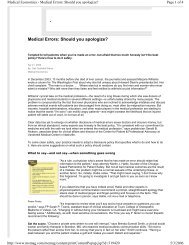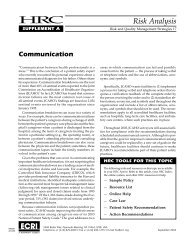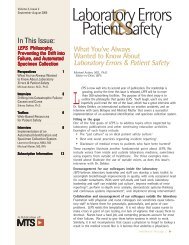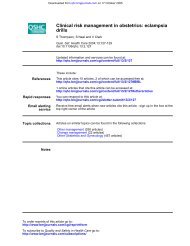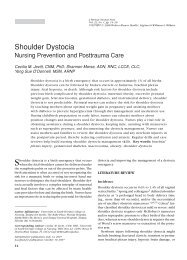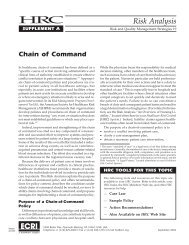Issue Brief - MCIC Vermont Patient Safety Documents
Issue Brief - MCIC Vermont Patient Safety Documents
Issue Brief - MCIC Vermont Patient Safety Documents
You also want an ePaper? Increase the reach of your titles
YUMPU automatically turns print PDFs into web optimized ePapers that Google loves.
Medical Errors: Five Years After the IOM Report 3• Performance StandardsOversight organizations, professional groups, andgroup purchasers of health care should help raiseperformance standards. Commission membersurged these groups to set and enforce explicitperformance standards for patient safety throughregulatory mechanisms such as licensing, certification,and accreditation, as well as defining minimumperformance levels for health professionals.• <strong>Safety</strong> Systems within Health Care Organizationsand <strong>Patient</strong> ResponsibilityHealth care organizations should implementsafety systems to ensure safe practices at thedelivery level. The report stressed the need forstrong leadership on the part of clinicians, executives,and governing bodies. It also noted thatpatients should take responsibility for their ownsafety by knowing what medications they takeand notifying their doctors about side effects. 13Five-Year Appraisal: Progress toward IOMRecommendations<strong>Patient</strong> <strong>Safety</strong> Center at AHRQWithin months of the IOM report, Congressinstructed the Agency for Healthcare Research andQuality (AHRQ) to establish a Center for <strong>Patient</strong><strong>Safety</strong> and lead a national effort to combat medicalerrors and improve patient safety. The HealthcareResearch and Quality Act (P.L 106-129) tookeffect in December 1999 and required AHRQ tobuild capacity to study and eliminate medicalerrors, develop systems to detect errors, and identifyand develop systems to enhance safety. The lawauthorized appropriations for five years. In the firstthree years, the center received $165 million. InFY 2004, the center received $80 million. 14 Thefunding of this center represents the federal government’ssingle largest investment in patientsafety. 15 Some experts argue that it is not enough. 16AHRQ’s efforts to reduce medical errorshave focused largely on developing centers ofexcellence in patient safety research, awardingtraining grants, and collaborating with professionalTable 1. AHRQ <strong>Patient</strong> <strong>Safety</strong> BudgetFiscal YearAppropriationFY 2001$50 millionFY 2002$55 millionFY 2003$55 millionFY 2004$80 millionFY 2005$84 millionNote: Of the $80 and $84 million in fiscal years 2004 and 2005, respectively,$50 million is earmarked for information technology development and theremainder is for patient safety research.Source: <strong>Patient</strong> <strong>Safety</strong> Mechanism Summary, 2004, Agency for HealthcareResearch and Quality, Budget Office.organizations. Charged with the job of disseminatingevidence-based best practices,* AHRQ commissionedthe University of California Evidence-Based Practice Center (EPC) to review the scientificliterature regarding safety improvement. Thecenter identified 73 interventions likely to improvesafety. Of these, 11 are considered highly effectivebut not performed routinely in hospitals and nursinghomes. In general, they are clinical interventions 17that decrease the risks associated with hospitalization,critical care, or surgery. Table 2 outlines thesepractices in descending order of effectiveness,beginning with the most highly rated.Identifying these interventions enabledAHRQ to create a set of guidelines for health careproviders to encourage improvements in patientsafety. 17 Information about these best practices hasbeen widely disseminated through interactive workshops,satellite broadcasts, and summary documents. 18The Agency for Healthcare Research andQuality has also developed three sets of Web-basedQuality Indicators (QI’s), which hospitals andother health care providers can download free ofcharge: Preventive Quality Indicators (PQIs),Inpatient Quality Indicators (IQIs), and <strong>Patient</strong><strong>Safety</strong> Indicators (PSIs). 19 All three use readilyavailable hospital inpatient administrative data. ThePQIs focus on hospitalizations that could havebeen avoided with timely access to outpatient careor conditions that could be less severe with early* Evidence-based best practice is the use of current, best evidence to makedecisions about health care delivery.
4 The Commonwealth FundTable 2. Most Highly Rated<strong>Patient</strong> <strong>Safety</strong> Practices• Appropriate use of prophylaxis to prevent venous thromboembolismin patients at risk.• Use of perioperative beta-blockers in appropriate patientsto prevent perioperative morbidity and mortality.• Use of maximum sterile barriers while placing centralintravenous catheters to prevent infections.• Appropriate use of antibiotic prophylaxis in surgical patientsto prevent postoperative infections.• Asking that patients recall and restate what they have beentold during the informed consent process.• Continuous aspiration of subglottic secretions (CASS) toprevent ventilator-associated pneumonia.• Use of pressure-relieving bedding materials to prevent pressureulcers.• Use of real-time ultrasound guidance during central lineinsertion to prevent complications.• <strong>Patient</strong> self-management for warfarin (Coumadin TM ) toachieve appropriate outpatient anticoagulation and preventcomplications.• Appropriate provision of nutrition, with a particularemphasis on early enteral nutrition in critically ill and surgicalpatients.• Use of antibiotic-impregnated central venous catheters toprevent catheter-related infections.Source: Making Health Care Safer: A Critical Analysis of <strong>Patient</strong> <strong>Safety</strong>Practices. 2001. Evidence Report/Technology Report: Number 43. Agencyfor Health Care Quality.interventions. 20 The IQIs measure the quality ofcare in hospitals and include inpatient mortality forcertain procedures and medical conditions; utilizationof procedures for which there are questions ofoveruse, underuse, and misuse; and volume of proceduresfor which there is some evidence that ahigher volume of procedures is associated withlower mortality. 21 The PSIs detect potential adverseevents such as surgical complications and iatrogenicconditions associated with hospitalization. 22The Quality Indicators (QIs) have been adoptedfor use by many hospitals and provider organizationsacross the country interested in performancemeasurement. 23Error-Reporting SystemsPerhaps the most controversial of the IOM recommendationsdealt with error-reporting systems.Research suggests that health professionals arereporting errors more truthfully than in the past. 24However, evidence also suggests that when physiciansdo disclose errors, some craft their statementsto avoid admission of guilt or explicit discussion ofthe error. 25 Doctors cite the fear of malpractice litigationas the principal reason why their error disclosureoften falls short of being truthful andcomprehensive. Physicians also state that greaterlegal safeguards are necessary for a mandatoryreporting system to be successful. 26 Advocates ofvoluntary reporting argue that the current faultbasedsystem, which places blame on the individual,will result in underreporting and functions as asignificant disincentive to disclose error.Proponents of mandatory reporting argue that voluntaryreporting will not produce complete information,making it less valuable for identifyingtrends, ensuring corrective action, and issuing publicreports. 27Experts differ regarding the most effectivereporting system. Some suggest that voluntary systemscombined with strict confidentiality may bethe best method to encourage health professionalsto report mistakes. 28 Others argue that mandatorysystems are most effective, given research showingthat hospitals report fewer care-related injuries instates with voluntary systems than in states thatmandate reporting. 29Prior to the IOM report, 15 states hadmandatory reporting systems. 30 These states variedin their definitions of adverse events. The IOMreport defined an adverse event as a serious injuryresulting from medical management, and not from31, 32the underlying condition of the patient.Numerous bills dealing with these issues remaindeadlocked in state legislatures. 33 Currently, 22states have mandatory reporting systems, covering63 percent of the U.S. population. 34 However, therelease of medical error data is sporadic across the
Medical Errors: Five Years After the IOM Report 5various systems. Generally, states that introducemandatory systems establish them in statute, ratherthan regulation. These systems protect collecteddata and only release data in aggregate form. Ofthe 22 states, seven release incident-specific data.Fourteen states issue or plan to issue aggregatereports. Of these, five issue or plan to issue aggregatereports with individual facilities identified. 35Performance StandardsBoth public and private health care systems havetried to elevate performance standards since releaseof the IOM report. The Joint Commission onAccreditation of Healthcare Organizations(JCAHO)* has begun to enforce a broad set ofstandards focusing on patient safety. 36 These includerevisions to existing standards in order to supporterror-reduction programs in accredited organizationsas well as to develop new safety standards. 37 JCAHOincorporated these standards into its survey process,which evaluates safety and quality for nearly 5,000hospitals. As part of its accreditation program,JCAHO also requires hospitals to conduct rootcauseanalyses of adverse events, a process to get atthe factors leading to errors. JCAHO encourages,but does not require, hospitals to report adverseevents. Recently, JCAHO began developing program-specificpatient-safety goals for each of itsaccreditation and certification programs. JCAHOalso surveys health care organizations that use newmedication management standards. 38,39The <strong>Patient</strong> <strong>Safety</strong> Task Force within theDepartment of Health and Human Services coordinatesa joint effort among HHS agencies toimprove existing systems and integrate data onmedical errors. 40 The task force has initiated twostrategies to create a coordinated reporting system.The first relies on the Agency for HealthcareQuality and Research to support a series ofdemonstration projects to identify the causes of* JCAHO is an independent, not-for-profit government organization thataccredits and evaluates more than 15,000 health care programs andorganizations.errors and to develop evidence-based systems fortheir reduction. In FY 2001, AHRQ awarded $25million to 24 demonstration projects. The secondstrategy is to develop national benchmarks forpatient safety promotion. In the short term, thegoal is to develop accurate assessments of adverseevents. In the long term, this project aims to collectreliable rates of patients’ error risk to be usedto compare progress in error reduction acrosshealth care facilities. 41Most notable in the private sector forimproving performance standards has been theLeapfrog Group, a consortium of several Fortune500 companies and other private and public healthcare purchasers. The Leapfrog Group encourageslarge employers to reward health plans and hospitalsthat make breakthrough improvements inpatient safety and quality. Several U.S. purchasersestablished the organization in 2000 to develop acommon set of purchasing standards to promotepatient safety and care quality. The consortium alsoasks hospitals to report publicly on how they meetfour standards, or “leaps,” proven to reduce preventablemedical errors: computerized physicianorder entry, evidence-based hospital referral, ICUphysician staffing, and the National QualityForum’s safe practices. 42<strong>Safety</strong> Systems within Health Care OrganizationsThe IOM report placed medication errors amongthe most common preventable mistakes in hospitals,contributing to more than 7,000 deaths annually.43 One recent study found that medicationerrors occur in nearly one of every five doses inhospitals and skilled nursing facilities. 44 To reducemedication error, the American HospitalAssociation (AHA), Health Research andEducation Trust (HRET), and the Institute forSafe Medication Practices (ISMP) have formed apartnership to promote safety. Since publication ofthe IOM report, the partnership has distributedthe ISMP Medication <strong>Safety</strong> Self Assessment to
6 The Commonwealth Fund1,400 hospitals in 2000 and 1,600 hospitals in2004. The assessment reviews medication safetypractices in hospitals, heightens awareness of keycharacteristics of a safe medication system, andprovides hospital leaders with an inventory of successfulpractices for reducing errors. In response tothe medication safety gaps identified in the firstround of surveys, AMA, HRET and ISMP developedPathways for Medication <strong>Safety</strong>, a set of educationaltools for hospitals to improve safety. 45Error-Reducing TechnologyIncreasingly, information technology is being usedto reduce errors. Computerized physician orderentry (CPOE) can reduce errors by 55 to 86 percent.46 However, upfront costs associated withimplementation, both financial and administrative,have been major deterrents. 47 As a result, CPOEimplementation has been slow; approximately 10percent of hospitals have made CPOE completelyavailable and approximately 7 percent of hospitalshave made CPOE partially available to physicians. 48The limited number of CPOE systems means thatmost patient safety reports cannot be generatedautomatically, making data collection mechanismscumbersome, expensive and sporadic. The lack ofstandardization also makes it difficult to aggregatedata or identify trends. 49 Only a fraction of hospitalshave implemented electronic health record systems.However, many hospitals have made progressimplementing computerized laboratory results. 50<strong>Patient</strong> ResponsibilityJCAHO and the Centers for Medicare andMedicaid Services (CMS) launched a national program,Speak Up, to urge patients to take a role inpreventing health care errors. The program distributesbrochures, posters, and buttons on patientsafety topics. For example, one brochure, HelpPrevent Errors in Your Care: For Surgical <strong>Patient</strong>s,offers tips to help patients prepare for surgery andto ensure that they have the correct procedureperformed at the correct site on their body.Another, Preparing to Be a Living Organ Donor,givesbasic facts about organ donations. 51Recent <strong>Patient</strong> <strong>Safety</strong> ActivityVeterans Administration ActivityPrior to the IOM report, the VeteransAdministration identified patient safety as a highpriority issue and began a <strong>Patient</strong> <strong>Safety</strong>Improvement Initiative. The VA launched aNational Center for <strong>Patient</strong> <strong>Safety</strong> to lead itspatient safety effort. The VA has also supported itspatient safety and quality improvement activitieswith a computerized patient record system andother clinical information systems. The VA requiresall of its hospitals to implement a bar code medicationadministration system to prevent errors indrug dispensing and blood transfusion. Pilot testsindicated that the technology reduced the medicationerror rate by 70 percent over a five-yearperiod. 52,53 The VA also partnered with theNational Aeronautics and Space Administration toapply the aviation error and near-miss reportingprocess to its health care delivery system. Together,the VA and NASA developed the <strong>Patient</strong> <strong>Safety</strong>Reporting System (PSRS), a voluntary, confidential,and nonpunitive program for the reporting ofevents and concerns related to patient safety.PSRS, designed to identify broad system vulnerabilities,serves as a complement to the VA’s mandatoryinternal reporting system. 54 Recently, theAgency for Healthcare Quality and Research partneredwith the VA’s National Center for <strong>Patient</strong><strong>Safety</strong> (NCPS) to create the <strong>Patient</strong> <strong>Safety</strong>Improvement Corps, a training program for statehealth officials and their hospital partners. TheCorps offers training based on NCPS patientsafety programs. In the first year, 50 organizationsfrom 14 states participated. 55 NCPS also has servedas an example for patient safety activities internationally,training patient safety representatives fromaround the world to apply the NCPS programstructure and principles to efforts in their respectivecountries. 56
Medical Errors: Five Years After the IOM Report 7Military Health Care System ActivityThe Department of Defense is implementing arange of electronic systems for recording andaccessing patient health information. DOD’sComposite Health Care System II (CHCS II) hasa long-term goal of incorporating nine millionmilitary personnel and their dependents into thesystem by 2006. A medical and dental clinicalinformation system, CHCS II generates, maintains,and provides secure online access to comprehensivehealth records. The Theater MedicalInformation Program gives deployed militaryphysicians immediate access to health data fortroops, allowing them to track trends across healthcare facilities. TRICARE Online enables militarybeneficiaries to schedule appointments online withprimary care physicians, search through medicalinformation, locate details about medical providers,and check for drug interactions. DOD recentlylaunched an integrated pharmacy system for beneficiaries,with the goal of allowing DOD physiciansto track prescriptions as they are filled inpharmacies worldwide. To strengthen its safetyprogram, the DOD implemented an error reportingsystem modeled after the VA’s. 57While both the VA and DOD have implementedsafeguards to protect their own patients,some patients receive medications and servicesfrom both agencies, and coordination problemsmay mean they are less well protected. Concernabout medication safeguards for shared patients hasled to a joint venture between the VA and DODto address medical safety problems regarding duallyeligible beneficiaries. 58Medicare ActivityThe Centers for Medicare and Medicaid Servicesrecently initiated the Hospital Quality Initiative,which aims to create a standard set of qualitymeasures for hospitals. One component is thequality incentive demonstration program in collaborationwith Premier Inc., a nationwide organizationof not-for-profit hospitals. The demonstrationinvolves 278 hospitals and uses financial incentivesto encourage quality care. Participating hospitalsthat provide high quality care are rewarded withincreased payments for Medicare patients. Hospitalsalso receive bonuses based on quality measures forselected clinical conditions, such as heart attack,heart failure, pneumonia, coronary artery bypassgraft, and hip and knee replacements. However,because the dollars are budget neutral, some hospitalsmay be paid less than they would have beenhad there been no demonstration. 59Private Sector ActivityKaiser Permanente, the nation’s largest private sectorhealth care delivery system, recently began a10-year, $3 billion national information technologyprogram, KP Health Connect. The goal is to computerizemedical records for Kaiser’s 11 millionmembers, with the long-term aim of giving Kaiserdoctors and nurses nationwide online access topatients’ medical information. Early indicatorsshow that electronic medical records are accessed10 times more frequently than paper records. 60State ActivitySeventeen states have formed, or are developing,statewide public/private patient safety coalitions.These programs focus on disseminations of bestpractices, mandatory and voluntary error reporting,education of policymakers and consumers, professionalaccountability, development of informationtechnology, and systems improvement. 61 Of thestates with patient safety coalitions, Massachusettsand Florida have made notable progress towardmedical error reduction and patient safety.In 1998, Massachusetts founded the firststate patient safety coalition, the MassachusettsCoalition for the Prevention of Medical Errors.The move was prompted by the death of a BostonGlobe medical reporter, Betsy Lehman, in 1994,following a chemotherapy overdose. The Coalitionhas been in the forefront of national activities topromote a systems-oriented approach to improving
8 The Commonwealth Fundpatient safety. 62 The Massachusetts Department ofPublic Heath (MDPH) was awarded a three-year,$4.5 million grant from the Agency for HealthCare Research and Quality to study the rootcauses of medical errors and devise appropriateprevention strategies. MDPH has worked on severalinitiatives, including improved systems forreporting errors and best practices to prevent commonerrors. Recently, the MDPH created a <strong>Patient</strong><strong>Safety</strong> Center to coordinate state agency initiatives,promote ongoing collaboration between the publicand private sectors, and coordinate state and federalpatient safety programs. 63In 2003, Florida passed the nation’s mostcomprehensive patient safety legislation, theMedical Incident Bill. The objectives are to createa near-miss reporting system, establish quality indicatorsfor consumers’ use in selecting hospitals, andcreate the Florida <strong>Patient</strong> <strong>Safety</strong> Authority—anorganization established to analyze patient safetydata, identify best practices, provide continuingeducation to practicing health care providers, andinstitute statewide electronic infrastructure. 64Meanwhile, a pilot project in Pennsylvania, a statethat requires near-miss reporting, found that 96percent of the medical error reports submittedwere for near-misses. A Commonwealth Fund–supported project in Pennsylvania and Minnesotais currently assessing whether near-miss reportingis associated with improvements in hospitals’underlying “culture of safety.” 65Liability ActivityIn response to criticisms of the medical liabilitysystem, the Institute of Medicine proposeddemonstration projects in 2002 to experimentwith alternative models for tort reform. Theseprojects aimed to create injury compensation systemsoutside of the courtroom that would providetimely, fair compensation to injured patients andpromote nonadversarial discussions betweenpatients and clinicians. They were also intended tocreate an environment that encouraged providersto report and analyze medical errors, involvepatients in safety improvement activities, andreward providers who put effective programs inplace to reduce medical injuries. 66 The existing literatureon medical liability and patient safety suggeststhat increased efforts toward tort reform arestill necessary. 67 Experts are calling for reform thatwill reduce the need for litigation by improvingrisk management, communication with patients,and fair compensation if injury occurs. 68Legislation in the 108th Congress 69The House and Senate passed similar but differentversions of the <strong>Patient</strong> <strong>Safety</strong> and Quality ImprovementAct in the 108th Congress. The legislationdid not go to conference. Both bills would have:• Created a national, voluntary database of nonidentifiablepatient safety data to track trends andidentify systems-based causes of medical errorsthat resulted in minor injuries or “near misses.” 70• Identified patient safety organizations (PSOs) tocollect and assess confidential safety data.• Made patient safety data privileged to prohibit itfrom being used against providers in litigation oradministrative proceedings.• Developed standards for communication ofhealth information using IT.The main differences between the Houseand Senate bills focused on definitions of patientsafety data, legal protections for patients, the role ofthe Agency for Healthcare Quality and Research,and FDA standards. The House bill defined patientsafety data as any documents and communicationsdeveloped by providers for reporting purposes. Itdid not include information that is part of traditionalmedical record keeping, such as medical orbilling records. The Senate legislation definedpatient safety data as any information, reports,records, memoranda, analyses, or statements that
Medical Errors: Five Years After the IOM Report 9could result in improved patient safety or qualityof care.Under the House legislation, patient safetyinformation would be protected from use in civiland administrative proceedings as well as fromFreedom of Information Act requests. The legalprotections in the Senate bill would shield patientsafety information from use in civil, and administrativeproceedings as well as criminal action unlessa judge determines that it contains evidence of anintentional act to harm the patient directly.The House legislation authorized theAgency for Healthcare Quality and Research toestablish a national database to receive and analyzeinformation submitted by patient safety organizationas well as develop voluntary national standardsto promote health information technology systems.The Senate bill instructed the Agency forHealthcare Quality and Research to maintain anetwork of databases to receive and analyze datareported by patient safety organizations andproviders as well as establish common standards forreporting the data. Finally, the House legislationdirected the FDA to issue standards for uniqueproduct identifiers, such as bar codes, on the packagingof drugs and biological products. The Senatebill did not include provisions for unique productidentifiers. 71Are <strong>Patient</strong>s Safer Five Years Later?The IOM report called for a 50 percent reductionin medical errors by 2004. Unfortunately, it is notpossible to quantify the number of errors today andtherefore impossible to determine if the goal hasbeen met. 72 Recent research suggests errors remainhigh and there are many issues around substandardquality in addition to error. 73, 74 Further-more, the1999 IOM report focused primarily on errors inhospitals, but errors occur in other settings, such asambulatory care and nursing homes. 75, 76 The IOM’s2001 publication, Crossing the Quality Chasm: ANew Health System for the 21st Century, highlightedthe overuse, misuse, and underuse of care, andcalled for a “fundamental change” in the healthcare delivery system. 77 As a summary statistic, theaverage patient receives only 55 percent of the servicesthat would benefit that individual. 78While the 1999 and 2001 IOM publicationscatalyzed a national movement toward error reductionand patient safety, physicians and the publichave not demonstrated a similar urgency. In 2001,more than one of five Americans reported they ora family member had experienced a medical error.Some researchers believe that the IOM figuresregarding medical errors may represent the tip ofthe iceberg. 79 In 2002, 35 percent of physicians and42 percent of the public reported errors in theirown or a family member’s care. Neither group,however, placed errors among the most importantproblems in health care. In fact, a majority of bothgroups believed that the number of in-hospitaldeaths due to preventable errors is lower thanIOM estimates. 80 Today, most Americans don’tbelieve the nation’s quality of care has improved. A2004 study found that 40 percent of people saidthe quality of care had gotten worse in the pastfive years, while 17 percent said quality had gottenbetter and 38 percent said it had stayed the same. 81Business Case for QualityQuality has become one of the most pressingissues facing the health care industry. That medicalcare appears to obtain less value from the resourcesit uses, relative to other industries, has been a keycatalyst for the recent movement toward a businesscase for quality. 82,83 One study found that unjustifiedvariation in the use of certain services hasbeen largely responsible for excessive costs inthe Medicare program. 84 Another concluded thatlow quality care is responsible for 30 percent ofall health expenditures by public and privatepurchasers. 85Research exploring the business case forquality focuses on aligning financial incentiveswith better quality care. The breadth of researchin this area is quite expansive, including hospital
10 The Commonwealth Fundquality, purchasing, pharmaceutical management,corporate wellness, tobacco cessation, and diabetesmanagement. 86 Despite this evidentiary base, fewpurchasers or consumers demand higher quality. 87Most purchasers use their purchasing power toobtain lower prices rather than higher quality. 88Survey data indicate that consumers want a widechoice among doctors and hospitals, low cost, andunimpeded access to their caregivers. Most consumersdo not ask for information about quality,health outcomes, or error rates. 89ConclusionFive years after the landmark 1999 IOM report, ToErr Is Human, presented its dramatic findings ofpreventable death and injury in U.S. hospitals,notable advances have been made. They includethe development of performance standards, anincrease in error reporting, integration of informationtechnology, and improved safety systems. The2001 IOM report, <strong>Patient</strong> <strong>Safety</strong>: Achieving a NewStandard for Care, suggests that efforts are stillneeded to improve safety and reduce errors. Thereport focuses on the development of data standardsfor patient safety information, the establishment ofa national health information infrastructure, and aneed for comprehensive patient safety program inhealth care organizations. 90 A successful approachto reducing medical errors and improving patientsafety is likely to reflect recommendations fromboth IOM reports.1NOTESEstimates were obtained from the Harvard PracticeStudy, a 1991 study that looked at over 30,000 patientrecords from 51 New York hospitals as well as a studyfrom Utah and Colorado that researched 15,000 hospitalrecords. These estimates are low since they onlyinclude deaths that occur in hospitals and do notaccount for the number of people who are injured,but do not die, as a result of medical errors. See:Brennan, T.A. et al. 1991. Incidence of adverse eventsand negligence in hospitalized patients: Results of theHarvard Medical Practice Study I. New England23456789Journal of Medicine. 324: 370–376; Leape, L.L. et al.1991. The Nature of Adverse Events in Hospitalized<strong>Patient</strong>s: Results of the Harvard Medical PracticeStudy II. New England Journal of Medicine. 324 (6):377–384; Thomas, E.J. et al. 2000. Incidence andTypes of Adverse Events and Negligent Care in Utahand Colorado. Medical Care.Institute of Medicine. 1999. To Err Is Human:Building a Safer Health Care System. Washington, DC:National Academy Press.Medical errors were not a new issue in 1999. Thebody of research describing the problem of medicalerrors began to emerge in the 1990’s, but did notgain national attention until after the publication ofthe IOM report. Also, the final report of thePresident’s Advisory Commission on ConsumerProtection and Quality in the Health Care Industry,released in 1998, identified medical errors as one ofthe four major challenges facing the nation inimproving heath care quality. Based on recommendationsfrom that report, the Quality InteragencyCoordination Task Force (QuIC) was established inHHS in 1998 to coordinate quality improvementactivities in Federal health care plans. See: NationalHealth Policy Forum. March 15, 2000. <strong>Issue</strong> <strong>Brief</strong>:Improving Quality and Preventing Error in MedicalPractice; Department of Health and Human Services.March 25, 2002. Fact Sheet: Improving <strong>Patient</strong> <strong>Safety</strong>and Preventing Medical Errors.Brennan, T.A. 2000. The Institute of MedicineReport on Medical Errors—Could It Do Harm?New England Journal of Medicine. 342: 1123–1125.Hayward, R.A. et al. 2001. Estimating HospitalDeaths Due to Medical Errors: Preventability Is inthe Eye of the Reviewer. JAMA. 286: 415–420.Jencks, S. 2000. Public Reporting of Serious MedicalErrors. Effective Clinical Practice. 3: 299–301.McDonald, C.J. et al. 2000. Deaths Due to MedicalErrors Are Exaggerated in the Institute of MedicineReport. JAMA. 284: 93–95.Leape, L.L. 2000. IOM Medical Error Figures AreNot Exaggerated. JAMA. 284 (1): 95–97.Leatherman, S. et al. 2002. Quality of Health Care inthe United States: A Chartbook. New York, NY: TheCommonwealth Fund.
Medical Errors: Five Years After the IOM Report 1110Institute of Medicine. 1999. To Err Is Human:Building a Safer Health Care System. Washington, DC:National Academies Press.11Ibid.12The report recommended that adverse event reportingshould initially be required of hospitals and eventuallymandatory for other institutional and ambulatorydelivery systems.13Institute of Medicine. 1999. To Err Is Human:Building a Safer Health Care System. Washington, DC:National Academies Press.14AHRQ’s <strong>Patient</strong> <strong>Safety</strong> Initiative: Building Foundations,Reducing Risk. Interim Report to the Senate Committeeon Appropriations. AHRQ Publication No.04-RG005. December 2003. Agency for HealthcareResearch and Quality, Rockville, MD. Retrievedfrom: http://www.ahrq.gov/qual/pscongrpt/.15Fact Sheet: Improving <strong>Patient</strong> <strong>Safety</strong> and PreventingMedical Errors. 2002. United States Department ofHealth and Human Services. http://www.hhs.gov.news/press/2002pres/safety.html.16Learning from Mistakes: Toward Error-FreeMedicine. 2004. Investigator Awards in Health Policy:Research in Profile. 11: 1-4.17Making Health Care Safer: A Critical Analysis of<strong>Patient</strong> <strong>Safety</strong> Practices. 2001. Evidence Report/Technology Report: Number 43. Agency for HealthCare Quality.18Fact Sheet: Improving <strong>Patient</strong> <strong>Safety</strong> and PreventingMedical Errors. 2002. United States Department ofHealth and Human Services. Retrieved from:http://www.hhs.gov.news/press/2002pres/safety.html.19PQIs were released in November 2001. IQIs werereleased in May 2002. PSIs were released in March2003. See: http://www.qualityindicators.ahrq.gov/index.htm.20Prevention Quality Indicators Overview. AHRQQuality Indicators. 2004. Agency for HealthcareResearch and Quality, Rockville, MD. Retrievedfrom: http://www.qualityindicators.ahrq.gov/pqi_overview.htm.21Inpatient Quality Indicators Overview. AHRQQuality Indicators. 2004. Agency for HealthcareResearch and Quality, Rockville, MD. Retrievedfrom: http://www.qualityindicators.ahrq.gov/iqi_overview.htm.22<strong>Patient</strong> <strong>Safety</strong> Indicators Overview. AHRQ QualityIndicators. 2004. Agency for Healthcare Research andQuality, Rockville, MD. Retrieved from:http://www.qualityindicators.ahrq.gov/psi_overview.htm.23As of October 2004, there were 2,612 downloads ofthe IQI software, 1,760 downloads of the PQI software,and 2,006 downloads of the PSI software. As afederal agency, AHRQ is limited in the ways it canobtain and track information about users of qualityindicators. Therefore, only limited case studies andanecdotal information is available about specific usesof the QIs. Conversation with Dr. Denise Remus,Senior Research Scientist, AHRQ.24Lamb, R.M. et al. 2003. Hospital Disclosure Practices:Results of a National Survey. Health Affairs. 22: 73-83.25Gallagher, T.H. et al. 2003. <strong>Patient</strong>s’ and Physicians’Attitudes Regarding the Disclosure of MedicalRecords. JAMA. 289 (8): 1001–1007.26Robinson, A.R. 2002. Physician and Public Opinionon Quality of Health Care and the Problem ofMedical Errors. Archives of Internal Medicine. 162:2186–2190.27Roscoe, L.A. et al. 2002. Reporting Medical Errors:Variables in the System Shape Attitudes TowardReporting Adverse Events. Bulletin of the AmericanCollege of Surgeons. 87 (9): 12–17.28Finkelstein, J.B. July 2004. Senate Passes <strong>Patient</strong> <strong>Safety</strong>Bill with New Error Reporting System. Retrievedfrom: http://www.ama-assn.org/amednews/2004/08/09/gv110809.htm.29Williams, L.K. et al. 2003. Differences in theReporting of Care-Related <strong>Patient</strong> Injuries to ExistingReporting Systems. Joint Commission Journal on Qualityand <strong>Safety</strong>. 29: 460–467.30States with mandatory reporting systems: CO, FL, KS,MA, NE, NJ, NY, OH, PA, RI, SC, SD, TN, TX, WA.States with voluntary reporting systems (including theDistrict of Columbia): DC, GA, NC, NM, OR, WY.See: Rosenthal, J. et al. 2000. State Reporting of MedicalErrors and Adverse Events: Results of a 50-State Survey.Portland, ME: National Academy for State HealthPolicy.
12 The Commonwealth Fund31Rosenthal, J. et al. 2000. State Reporting of Medical Errorsand Adverse Events: Results of a 50-State Survey. Portland,ME: National Academy for State Health Policy.32Institute of Medicine. 1999. To Err Is Human:Building a Safer Health Care System. Washington, D.C.:National Academies Press.33106 medical-error related bills have been introducedin state legislatures since 1999. See: NationalAcademy for State Health Policy. Fast Facts.Retrieved from: http://www.nashp.org/_catdisp_page.cfm?lid= 59d44f84-32b5-11d6-BCEA00A0CC558925.34States with mandatory reporting systems at the end of2003: CA, CO, CT, GA, FL, KS, MA, MD, ME, MN,NJ, NV, NY, OH, PA, RI, SC, SD, TN, TX, UT, WA.See: Marchev, M. 2003. http://www.nashp.org.35Rosenthal, J. 2003. How States Report Errors to thePublic: <strong>Issue</strong>s and Barriers. Portland, ME: NationalAcademy for State Health Policy.36In 2001, JCAHO enforced patient safety standards inhospitals. These standards were extended to includebehavioral health care and long-term care organizationsin 2003. In 2004, they were expanded to homecare organizations. See: Facts About <strong>Patient</strong> <strong>Safety</strong>.Joint Commission on Accreditation of HealthcareOrganizations, http://www.jcaho.org/accredited+organizations/patient+ safety/facts+about+patient+safety.htm.37Comprehensive Accreditation Manual for Hospitals. 2001.Joint Commission on Accreditation of HealthcareOrganizations.38Joint Commission on Accreditation of HealthcareOrganizations. 2003. National <strong>Patient</strong> <strong>Safety</strong> Goals.Retrieved from: http://www.jcaho.org/accredited+organizations/patient+safety/facts+about+patient+safety.htm.39Rich, D.S. 2004. New JCAHO MedicationManagement Standards for 2004. American Society ofHealth-System Pharmacists. 61(1): 1349–1358.40HHS departmental agencies included in the <strong>Patient</strong><strong>Safety</strong> Task Force: Agency for Healthcare Researchand Quality (AHRQ), Centers for Disease Controland Prevention (CDC), Food and DrugAdministration (FDA), and Centers for Medicareand Medicaid Services (CMS).41<strong>Patient</strong> <strong>Safety</strong> Task Force Fact Sheet. Department ofHealth and Human Services. See: http://www.premierinc.com/all/safety/resources/patient_safety/downloads/05_AHRQ_factsheet.pdf.42See: http://www.leapfroggroup.org/.43Institute of Medicine. 1999. To Err Is Human:Building a Safer Health Care System. Washington, DC:National Academy Press.44Barker, K.N. et al. 2002. Medication Errors Observedin 36 Health Care Facilities. Archives of InternalMedicine.162: 1897–1903.452004 ISMP Medication <strong>Safety</strong> Self Assessment forHospitals. Institute for Safe Medication Practices.Retrieved from: http://www.ismp.org/PDF/2004Hosplrg.pdf.46Selected References: Dexter, P.R. et al. 2001. AComputerized Reminder System to Increase the Useof Preventive Care for Hospitalized <strong>Patient</strong>s. NewEngland Journal of Medicine. 345: 965–970; Teich, J.K.et al. 2000. Effects of Computerized Physician OrderEntry on Prescribing Practices. Archives of InternalMedicine. 160:2741–2747; Bates, D.W. et al. 1997.Does the Computerized Display of Charges AffectInpatient Ancillary Test Utilization? Archives ofInternal Medicine. 157: 2501–2508; Bates, D.W. et al1999. A Randomized Trial of a Computer-BasedIntervention to Reduce Utilization of RedundantLaboratory Tests. American Journal of Medicine. 106:144–150; Bates, D.W. et al. 1998. Effect ofComputerized Physician Order Entry and a TeamIntervention on Prevention of Serious MedicationErrors. JAMA. 280: 1311–1316; Bates, D.W. et al.1999. The Impact pf Computerized Physician-OrderEntry on Medication Error Prevention. Journal of theAmerican Medical Informatics Association. 6: 313-321.47Kuperman, G.J. 2003. Computer Physician OrderEntry: Benefits, Costs and <strong>Issue</strong>s. Annals of InternalMedicine. 139: 31–39.48Ash, J.S. et al. 2004. Physician Order Entry in U.S.Hospitals: Results of a 2002 Survey. Journal of theAmerican Medical Informatics Association. 11: 95–99.49Institute of Medicine. 2004. <strong>Patient</strong> <strong>Safety</strong>: Achieving aNew Standard for Care. Washington, DC: NationalAcademies Press.
Medical Errors: Five Years After the IOM Report 1350Brailer, D.J. January 2003. Use and Adoption ofComputer-Based Medical Records in the UnitedStates: A Review and Update. Presentation to theIOM Committee on Data Standards. Retrievedfrom: http://www.iom.edu/Object.File/Master/10/988/0.pp.51See: http://www.jcaho.org/accredited+organizations/patient+safety/facts+about+patient+safety.htm#9.52United States General Accounting Office. 2000.Testimony of Cynthia A. Bascetta before the Subcommitteeon Oversight and Investigations, Committeeon Veteran’s Affairs, House of Representatives. VA<strong>Patient</strong> <strong>Safety</strong>: Initiatives Promising but Continued ProgressRequires Culture Change. GAO/T-HEHS-OO-167.53Findlay, S., ed. 2000. Reducing Medical Errors andImproving <strong>Patient</strong> <strong>Safety</strong>: Success from the Front Linesof Medicine. Washington, DC: National Coalition onHealth Care and Institute for Healthcare Improvement.54See: http://psrs.arc.nasa.gov/web_docs/PSRS_Brochure.pdf.55See: http://www.patientsafety.gov/NewsRels/PSIC.doc.56Stalhandske, E. et al. 2002. Department of VeteransAffairs <strong>Patient</strong> <strong>Safety</strong> Program. American Journal ofInfection Control. 30 (5): 296–302.57See: http://www.ha.osd.mil/.58United States General Accounting Office. 2002.Report to Chairman, Subcommittee on Defense,Committee on Appropriations, U.S. Senate. VA andDefense Health Care: Increased Risk of Medication Errorsfor Shared <strong>Patient</strong>s. GAO-02-1017.59See: http://www.cms.hhs.gov/quality/.60This study was conducted at Kaiser’s Coloradoregion. Data indicate that before implementation ofelectronic medical records, paper charts wereretrieved 90,000 per month. After implementation,electronic medical records patient charts wereaccessed one million times per month. Statement ofAndrew M. Wiesenthal, M.D., Associate ExecutiveDirector, Kaiser Permanente. June 17, 2004.Testimony Before the Subcommittee on Health ofthe House Committee on Ways and Means.61The 17 states with patient safety organizations are:AR, CA, CO, FL, GA, IA, MA, MD, MI, MN, OH,PA, TN, TX,VA, UT, WI. See: Comden et al. 2002.Statewide <strong>Patient</strong> <strong>Safety</strong> Coalitions: A Status Report.Portland,ME: National Academy for State Health Policy.62See: http://www.macoalition.org/.63MDPH Creates a New <strong>Patient</strong> Center to ReduceMedical Errors. January 12, 2004. See:http://www.mass.gov/dph/media/2004/pr0112.htm.64The legislation also included provisions focused onmedical negligence. See: http://umdas.med.miami.edu/MPSC/the_projectsahca.html.65Commonwealth Fund grant to ECRI,“PromotingHospitals’ Culture of <strong>Safety</strong>: Assessing the Merits ofState Adverse Event and Near-Miss Reporting,”approved Nov. 9, 2004. See: http://www.cmwf.org/grants/grants_show.htm?doc_id=248527.66Institute of Medicine. 2003. Fostering Rapid Advancesin Health Care: Learning from System Demonstrations.Washington, DC: National Academies Press.67Sage, W. 2003. Understanding the First MalpracticeCrisis of the 21st Century. Health Law Handbook. ed.Alice Gosfield, West Law.68Sage, W. 2003. Medical Liability and <strong>Patient</strong> <strong>Safety</strong>.Health Affairs. 22 (4): 26–36.69This legislation is also discussed in the backgroundbrief, International Innovations in Health Care: QualityImprovement in the UK, by Gillian SteelFisher. Further,both briefs share language pertaining to the legislation.In addition, both rely heavily on: Redhead, C.S.November 26, 2003. <strong>Patient</strong> <strong>Safety</strong>: Legislation toPromote Voluntary Reporting of Medical Errors. CRSReport for Congress. Washington, DC: CongressionalResearch Service.70Neither bill addressed mandatory reporting to stateagencies of errors that result in serious injury or death.71Redhead, S.C. 2003. <strong>Patient</strong> <strong>Safety</strong>: Legislation toPromote Voluntary Reporting of Medical Errors.Congressional Research Service.72Robert Wachter, M.D., a leading authority on medicalerrors based at the University of California SanFrancisco Medical Center, believes that the nation’sresponse to the IOM’s call to action rates only a‘C+’. See “The End of the Beginning: <strong>Patient</strong> <strong>Safety</strong>Five Years After To Err Is Human, Robert M. Wachter,M.D., Health Affairs Web Exclusive, November 30,2004 W4-534–W4-545.
14 The Commonwealth Fund73Berwick, D.M. 2003. Errors Today and ErrorsTomorrow. New England Journal of Medicine. 348: 25.74Millenson, M.L. 2003. The Silence. Health Affairs.22 (2): 103–104.75Gurwitz J.H. et al. 2000. Incidence and Preventabilityof Adverse Drug Events in Nursing Homes. AmericanJournal of Medicine. 109 (2): 87–94.76Gurwitz J.H. et al. 2003. Incidence and Preventabilityof Adverse Drug Events Among Older Persons in theAmbulatory Setting. JAMA. 289 (9): 1107–1116.77Institute of Medicine. 2000. Crossing the QualityChasm: A New Health System for the 21st Century.Washington, DC: National Academies Press.78McGlynn et al. 2003. The Quality of Health CareDelivered to Adults in the United States. NewEngland Journal of Medicine. 348 (26): 2635–2645.79Davis, K. et al. 2002. Room for Improvement: <strong>Patient</strong>sReport on the Quality of Their Health Care. TheCommonwealth Fund.80Blendon, R.J. et al. 2002.Views of PracticingPhysicians and the Public on Medical Errors. NewEngland Journal of Medicine. 347 (24): 1933–1940.Study of Henry Ford Heath System. TheCommonwealth Fund; McGlynn, E.A. et al. 2003.The Business Case for a Corporate Wellness Program: ACase Study of General Motors and the United AutoWorkers Union. The Commonwealth Fund; March, A.2003. The Business for Tobacco Cessation Programs: ACase Study of Group Health Cooperative in Seattle. TheCommonwealth Fund; Beaulieu, N.D. 2003. TheBusiness Case for Diabetes Disease Management at TwoManaged Care Organizations: A Case Study ofHealthPartners and Independent Health Association. TheCommonwealth Fund.87Maio,V. et al. 2003. Value-Based Purchasing: A Reviewof the Literature. The Commonwealth Fund.88Becher, E.C. et al. 2003. Improving Quality,Minimizing Error: Making It Happen. Health Affairs.20(3): 68–82.89Hibbard J. et al. 1996. What Type of Information DoConsumers Want in a Health Care Report Card?Medical Care Research and Review. 53(1): 28–47.90Institute of Medicine. 2003. <strong>Patient</strong> <strong>Safety</strong>: AchievingNew Standards for Care. Washington, DC: NationalAcademies Press.81National Survey on Consumer’s Experiences with <strong>Patient</strong><strong>Safety</strong> and Quality Information: News Release.November 2004. Kaiser Family Foundation, Agencyfor Healthcare Quality and Research, and theHarvard School of Public Health.82Newhouse, J.P. 2002. Why Is There a Quality Chasm?Health Affairs. 21 (4): 13–26.83Galvin, R.S. 2001. The Business Case for Quality.Health Affairs. 20 (6): 57–59.84Wennberg, J.E., et al. 2002. Geography and theDebate Over Medicare Reform. Health Affairs.WebExclusive. W96–W114.85Midwest Business Group Health (MBGH). 2002.Reducing the Costs of Poor-Quality Health Care ThroughResponsible Purchasing Leadership. Chicago: MGBH.86See for example: Meyer, J.A. 2004. Hospital Quality:Ingredients for Success—Overview and Lessons Learned.The Commonwealth Fund; Maio,V. et al. 2003.Value-Based Purchasing: A Review of the Literature. TheCommonwealth Fund; Smits H. et al. 2003. TheBusiness Case for Pharmaceutical Management: A Case
Other issue briefs produced for The Commonwealth Fund/John F. KennedySchool of Government 2005 Bipartisan Congressional Health Policy ConferenceAlzheimer’s Disease: Research Advances and Medical Reality, Erica SeiguerState Preparedness for Bioterrorism and Public Health Emergencies, Rachel GarfieldOptions for Federal Coverage of the Uninsured in 2005, Erin C. Strumpf and Juliette CubanskiProtecting the Nation’s Health: Ensuring a Stable Supply of Influenza Vaccine, Erica SeiguerInternational Innovations in Health Care: Quality Improvements in the United Kingdom, Gillian K. SteelFisherMedicare: Making It a Force for Innovation and Efficiency, Jessica Mittler<strong>Issue</strong>s Related to State and Employer Innovations in Insurance Coverage, Erin C. StrumpfThe Commonwealth Fund is a private foundation supporting independent research on health and social issues.The views presented here are those of the authors and not necessarily those of The Commonwealth Fund or itsdirectors, officers, or staff.


